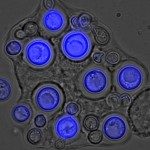Link to Pubmed [PMID] – 17341623
Ann. N. Y. Acad. Sci. 2006 Dec;1091:296-309
Insulin-like growth factor-binding protein-1 (IGFBP-1) is one of the genes involved in glucose homeostasis. In vivo, its level is increased by counter-regulatory hormones (glucocorticoids and glucagon via its second messenger cAMP) and decreased by insulin, these variations being primarily correlated with IGFBP-1 gene transcription. Previous reports described a functional insulin response element (IRE), immediately 5′- to the glucocorticoid response element (GRE). This IRE has been shown to mediate partial inhibition (1) of basal IGFBP-1 promoter activity and (2) of glucocorticoid-induced stimulation of gene transcription by insulin. In this work, using human HepG2 hepatoma cells as a model system, we showed: (1) that insulin inhibited both basal and cAMP-induced hIGFBP-1 promoter (nt-1 to -341) activity; (2) that in the absence of insulin, forkhead box class O (FOXO) transcription factors enhance constitutive hIGFBP-1 promoter activity without interfering with the stimulatory effect of cAMP; (3) that PI-3′ kinase signaling is involved in the inhibition of constitutive and cAMP-induced promoter activities by insulin; (4) that wild-type FOXO-1 mediates the inhibitory effect of insulin on the promoter, although FOXO-1(Ala3), a nonphosphorylatable mutant of FOXO-1, does not; (5) that the cAMP-responsive unit (CRU), that includes a putative IRE (nt-265 to -282) and a cAMP responsive element (CRE; nt-258 to -263), is sufficient per se to mediate both cAMP stimulation of a heterologous promoter, and inhibition of both basal and cAMP-induced promoter activities by insulin; and (6) that the inhibitory effects of insulin on the isolated CRU are mediated by the FOXOs. This study is the first evidence for the occurrence of a second IRE within hIGFBP-1 promoter sequences, IRE(CRU), located 5′- to the CRE.
